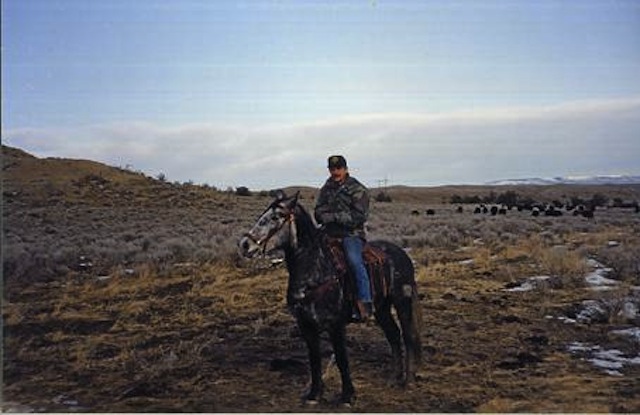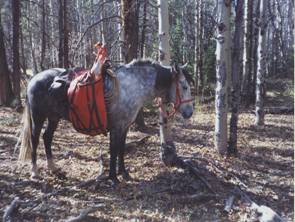| ||||||||||
Dr. Ronald P. Rogers CHIROPRACTOR Support for your body's natural healing capabilities 270-384-5554 Click here for details 


Columbia Gas Dept. GAS LEAK or GAS SMELL Contact Numbers 24 hrs/ 365 days 270-384-2006 or 9-1-1 Call before you dig Visit ColumbiaMagazine's Directory of Churches Addresses, times, phone numbers and more for churches in Adair County Find Great Stuff in ColumbiaMagazine's Classified Ads Antiques, Help Wanted, Autos, Real Estate, Legal Notices, More... 
|
Buster the Wild Mustang: A Tribute to a Great Horse "I was once told by an old Montana cowboy that if in your life you are fortunate enough to have had one good woman, one good dog, and one good horse, you were indeed a very lucky man. I consider myself a very lucky man!!!' - BILL TROUTWINE, Pellyton, Adair County, KY Click on headline for complete story with photo(s). Bill has graciously consented, at the request of ColumbiaMagazine.com, to share this story with CM Readers. The next earlier Bill Troutwine Story: Winter - My Last Montana Winter . Posted January 12, 2014. By Bill Troutwine Donna and I were living in Bullitt County, KY. and I was working as a firefighter at the Indiana Army Ammunition Plant. I had just been notified that I was going to be laid off, and the plant was closing. I have always loved the west, and dreamed of living there, so we thought this was the perfect opportunity to move. We found a country store for sale in Belfry, Montana; we bought it and moved there in February, 1991. Donna ran the store and after a short while I started working for The Red Lodge, Montana Police Dept. Belfry is only about 20 miles from Red Lodge, so it wasn't much of a commute for me and we needed the extra money. I had six horses in Kentucky (actually 4 horses and 2 mules), and I decided to take them with me. Most of my horses were adequate in the mountains, but not outstanding horses like everyone wants for the mountains. However, one of the six horses I took was good enough, that she stayed with me for the nearly fourteen years we spent in Montana. That little Appaloosa mare was Pal. She actually belonged to Penny, my youngest daughter. Pal was foaled on our family farm in Kentucky, and was named Penny's Pal, but known simply as 'Pal.' Pal was a very spunky mare and managed to handle herself very well in the mountains. I used Pal a lot, but she was small, and I needed a really good stout mountain horse for myself. One day, a friend of mine told me of an auction where they were selling wild mustangs. He said, "I hear mustangs make excellent mountain horses if you can ever break them." We decided to attend the auction in Powell, Wyoming. When we arrived at the auction, there was a big grey stallion that caught my eye. He had beautiful color. He was a silver grey with big dark dapple circles over his body, and he was unusually large for a mustang. He wasn't very tall, but he was extremely heavy muscled and weighed around 1,200 pounds. I mentioned how I liked his looks to my friend, and he said, "Stay away from him. He's a stallion, and he has been wild too long. You will never be able to break him." When he came up for sale, I did not bid on him, because of my friend's advice. No one else bid on him either, and he was not sold. Everyone else must have thought like my friend, that he would not be trainable. My friend bought two yearling mustangs, but I didn't buy any. I kept looking at the big grey. I even walked over to the pen where he was. I looked the horse over very closely, and I liked the look out of his eye. I thought he had a kind looking eye; however, I couldn't get as close a look as I would have liked, because he would constantly run to the furthest corner of the pen when approached. I walked over to the sales office and asked what they would do with the grey stallion. The clerk told me he would have to go for dog food, because no one bought him. I said, "What will it take to buy him?" He told me $500, which would also cover all the vet fees for health certificates, and even include castration if I wanted it done. He said, "It is only fair to warn you, he is six years old, and I seriously doubt you will ever be able to handle him." I decided to buy him and take a chance on training him. I told them to go ahead and castrate him. They said I would have to leave him there for about a week. They would shoot him with a tranquilizer gun, castrate him, and then give him about a week to settle down, before I could move him. One week later, I arrived back at the BLM (Bureau of Land Management) pens to pick up my mustang. Donna was with me, and she looked at the horse. He was running around in the pen, snorting, blowing, and hitting the sides of the pen trying to get out. She said, "What in the world are you going to do with him? Anyone would know that horse is unbreakable." I said, "I'm going to give it a try, and if I can't break him I guess I'll have to sell him for dog food!" They ran the horse into a tall tight squeeze chute. We put a halter and a blindfold on him, and then we loaded him in my closed in trailer. The BLM Rangers who helped me load my mustang, told me to leave the blindfold on him until I had him in a stout secure stall. One of them said, "When the blindfold comes off the horse will go crazy." I made it home without incident and took him to a friend's barn that had a big box stall made with heavy rough cut 2x8 oak boards that reached clear to the ceiling of the barn. We backed up to the door of the stall and were able to get him in the stall. I jerked the blind fold off, then leaped out, and slammed the door of the stall. My new mustang reared up, snorting, and blowing, and ran to the far corner of the stall and started pawing the floor. I had read about an old Indian trick used to break wild horses and decided to try it, since I had no other options for breaking him. Basically, you starved the animal into submission. The next day, I went to his stall with some hay in my hand. I tossed a small bite of hay to him, and he picked it up and gobbled it down. I then, held it in my hand and softly talked to him. I said, "Well, Buster, "If you eat anything else, you will eat it from my hand or you'll starve." After that morning, I started referring to him as 'Buster.' That name stuck. From then on, everyone called him 'Old Buster.' I continued to go into the stall, two or three times a day and hold hay in my hand to try to entice him into taking a bite. This went on for a week. He did not take a bite from my hand, so he had not eaten anything for a week. I gave him water, but absolutely no food. On the eighth day, he started towards me and reached his neck way out trying to reach the hay in my hand, but before he got a bite, he would lunge backwards away from me. We repeated this many times. Then after about an hour, he actually took a bite from my hand. When he did this, I threw him a small portion of hay and walked out. We went through this routine for several days, until finally, he stood there and ate from my hand, and I would rub his neck. After many days of feeding and fooling with him, I snapped a lead line on him and started walking him around in circles inside the stall. One day, I decided to see what he would do if I tried to put a saddle on him. I placed a saddle on his back, and he did nothing. From then on, I put the saddle on before I would lead him around. After a few days, I took him outside and led him around inside the corral. He was responding so well, I thought I would like to see what he would do, if I put some weight on his back. Robin, my step-daughter, had been living with us and met a cowboy named Pete. He managed one of the largest ranches in Montana. She and Pete had recently married. Robin was now living on the ranch and regularly working cattle from horseback with Pete. One day she was at the store, and she asked me how things were going with Buster. I said, "Things are going well. I would like to get someone to climb up on his back while I lead him. If I could find someone to do it, I think he would do fine as long as I am leading him, but I can't lead him and ride him at the same time." She said, "I'll do it." I said, "Let's go to the barn and see what happens." Donna threw a fit. She told Robin, "You are crazy. That horse will kill you. And, Bill, you are crazy for suggesting such a stupid thing." Against her protest, Robin and I headed to the barn anyway, and I saddled Old Buster. I got a tight grip on his halter, and rubbed him. As I softly talked to him, I told Robin to get on him slowly. She did, and he did nothing. I led him in circles around the corral. Then, we decided to lead him out of the coral and see how he would respond. This would be the first time he was outside of a high fence, since he was captured about two months ago. He led perfectly, and we decided to lead him about a half mile down the road to the store and let Donna see how well Buster was responding to the training. Donna could not believe that he let me lead him down the road, especially, with Robin on his back, and he was doing nothing. Buster was starting to look like a broke horse. The next day I rode Buster by myself with no problem. A week later, I took Buster on a cattle roundup with Pete and Robin. I was able to do almost anything with Buster, but for about a year, if anyone other than me, got near him, especially, if I wasn't standing right beside him, he would lay his ears back and bite them. After a couple of years, he became friendlier with strangers, but he was never totally comfortable with anyone except me. Bill & Buster. This was the first time Buster was ridden outside of a corral. He went on a cattle drive. For three years, no one had ridden him except me, other than that first time, when I led him with Robin. Then one day my sister came for a visit. We went on a horse trip in the mountains. I asked if she wanted to trade horses and see how Buster rode. We traded, and she rode Buster, and she said he had a very nice ride. Although, he would permit other people to ride him, he was still definitely a one man horse. Buster did everything I ever asked of him. Buster was the perfect mountain horse. I have had him in places a mountain goat wouldn't go. I have packed bear, elk, deer, and even a human body out of the mountains strapped on his back. I once took him over a suspension bridge designed for foot traffic only, crossing a canyon more than 500 feet deep. The bridge was swaying and Buster's feet were unsteady, but as I led and coaxed him, he reluctantly followed me until we were across the bridge. It was an extra ten mile ride to go through the canyon around the bridge, but I decided to go back the long way, rather than make Buster cross that bridge again. Buster served me well and literally carried me hundreds of miles through the big, wild, and rugged Rocky Mountains. My reputation of being a very successful elk hunter is in no small part, due to having one of the best mountain horses ever! Buster is a legend among my hunting buddies. They were always trying to find a horse like Buster, but with no success. I have been fortunate enough to own two wonderful and loyal horses in my life. One was a horse I had as a kid. I got Dusty when he was three years old, and I kept him until he died at age thirty. He was one of those horses that tried to do everything you asked of him. Most of my family learned to ride on Dusty's back. Shela, Melissa, Penny, and my first wife, Eloise, all learned to ride on Dusty. Dusty taught me a lot about horses, and he set a standard that I judged other horses by. None was able to reach that standard, until Buster came along. Out of more than a hundred horses I have owned, Buster and Dusty are the only two horses that met the test! They both were great horses, and I have been so blessed to have owned both of them. Penny's mare, Pal, is a very good horse also. Though a little small, she has spunk and a heart to make up for her size. Penny has a lasting fondness for her little Appaloosa Mare. As Dusty, set the horse standard for me, Pal has set the standard for Penny. Penny said she has not found another horse that even comes close to measuring up to her Pal, and she fears she never will. Buster, the horse that almost became dog food, moved back to Kentucky from Montana with me, and I also brought Penny's little mare back. Buster and Pal are both still alive; although, both are very old. Buster is here on the farm, where I live, and Pal is with Penny in Shelbyville. I vowed to keep Buster as long as he lives. He served me so well in Montana. I owe it to him to let him live out the rest of his life quietly in a big pasture with grass belly tall. At this writing, Buster is 25 years old, and Pal is 27. I was once told by an old Montana cowboy that if in your life you are fortunate enough to have had one good woman, one good dog, and one good horse, you were indeed a very lucky man. I consider myself a very lucky man!!! Authors Note: I wrote this story as a tribute to the best mountain horse I ever saw. Buster passed away December 3, 2013. He died here on my farm. If he was aged accurately when he was captured then he would have been almost 29 years old. Pal the little appaloosa mare is still living although she has been blind for the last 3 years. If she makes it to March 18, 2014 she will be 31 years old. --Bill Troutwine This story was posted on 2014-01-15 09:47:48
Printable: this page is now automatically formatted for printing.
Have comments or corrections for this story? Use our contact form and let us know.
More articles from topic News:
Adair County Fiscal Court, January 14, 2014 report Just like on television: 3D printer saves the day for hospital Surprise Birthday Celebration to be held for Jannie Luttrell Antioch Christian Ministries has new directory listing ACMS Homecoming is Thursday, January 16, 2014 Adair Co. wins 3rd straight, defeats LaRue 51-38 Columbia Rotary has best meeting ever W.M. Feese Jr Poem: Duck Dynasty ACMS student rescues fawn from ice covered water Adair County Food Pantry will be open today View even more articles in topic News |



|
||||||||
|
| ||||||||||
|
Quick Links to Popular Features
Looking for a story or picture? Try our Photo Archive or our Stories Archive for all the information that's appeared on ColumbiaMagazine.com. | ||||||||||
|
Contact us: Columbia Magazine and columbiamagazine.com are published by Linda Waggener and Pen Waggener, PO Box 906, Columbia, KY 42728. Please use our contact page, or send questions about technical issues with this site to webmaster@columbiamagazine.com. All logos and trademarks used on this site are property of their respective owners. All comments remain the property and responsibility of their posters, all articles and photos remain the property of their creators, and all the rest is copyright 1995-Present by Columbia Magazine. Privacy policy: use of this site requires no sharing of information. Voluntarily shared information may be published and made available to the public on this site and/or stored electronically. Anonymous submissions will be subject to additional verification. Cookies are not required to use our site. However, if you have cookies enabled in your web browser, some of our advertisers may use cookies for interest-based advertising across multiple domains. For more information about third-party advertising, visit the NAI web privacy site.
| ||||||||||





















































